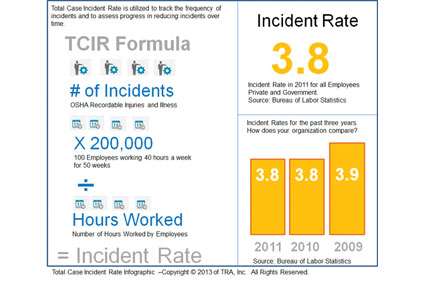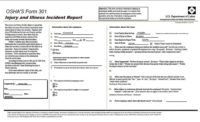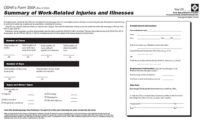Plus, we review potential changes in OSHA recordkeeping due to the Notice of Proposed Rule 29 CFR Parts 1904 and 1952 - Improve Tracking of Workplace Injuries and Illnesses.
Who is required to complete OSHA Recordkeeping?
Employers, under OSHA jurisdiction, with more than 11 employees who are not in partially exempt industries are required to keep OSHA recordkeeping logs. (Partially exempt industries are generally low risk industries and can be found in Appendix A to 29 CFR 1904.)
What are the recordkeeping logs?
Establishments are required to track information on work-related injury and illness that meet the OSHA recordability threshold on the applicable OSHA recordkeeping logs. Work-related incidents are OSHA recordable if they meet the following requirements:
Death,
Loss of consciousness,
Days away from work,
Restricted work activity or job transfer, or
Medical treatment beyond first aid
Additional criteria for occupational illnesses including hearing loss, needlestick injury and
tuberculosis.
Recordkeeping logs are required by each establishment or location, so organizations with multiple locations are required to complete OSHA recordkeeping logs for each location. Organizations are responsible for completing three types of recordkeeping log: 301, 300, and 300A logs.
The OSHA 301 log is an incident summary describing the who, what, when and where of each OSHA Recordable Incident. OSHA requires an OSHA 301 to be completed seven days after the incident is reported. An equivalent form can be utilized.
The OSHA 300 log contains a line item for each OSHA recordable incident and each location must have its own OSHA 300 log. For each incident, the OSHA 300 log must include a count of the number of missed and restricted days.
The OSHA 300A log is an annual summary of all OSHA Recordable incidents at each location. The OSHA 300A log of the previous year’s incidents must be posted for employees to view from February 1 to April 30. This log includes Total Hours worked and Total Number of Missed and Restricted Days.
Did you know? Locations that do not have any OSHA recordable incidents are still required to post their OSHA 300A logs.
What is rate reporting?
Incident rates including Total Case Incident Rate (TCIR) and Days Away Restricted Transfer Rate (DART) are utilized to track the frequency of OSHA recordable injuries and illnesses and to assess progress in reducing incidents over time. These rates can then be reviewed by month, department or facility location, providing supervisors with the ability to track incidents across multiple facilities and departments.
Successful OSHA recordkeeping
To make sure your organization successfully completes OSHA recordkeeping, follow these tools and tips:
• Ensure multiple individuals in the organization (including executive management) understand the basic requirements and importance of OSHA recordkeeping.
• Implement Standard Operating Procedures for reporting of employee injury and illnesses including appropriate forms and notifications.
• Update and review OSHA recordable incidents on a regular basis (while the 301 form or similar is supposed to be completed within 7 days of the incident), OSHA does not currently require that the 300 or 300A be updated continually.
• Track Hours worked on an ongoing basis. The OSHA300A form includes total hours worked. Tracking hours on an ongoing basis will save in last minute scrambling and also allow you to analyze your injury and incident rates in real-time.
• Use of software to assist in OSHA recordkeeping. Software is available that allows organizations to record incidents and injuries and will assist in determining the OSHA recordability of an incident. These systems will also allow you to enter multiple types of incidents and generate the appropriate 301, 300 and 300A logs for OSHA recordable incidents at multiple locations. OSHA recordkeeping software can also allow you to track hours worked and calculate the appropriate rate reports (saving time and increasing accuracy of these calculations).
Recordkeeping changes down the road?
OSHA currently requires employers to post the 300A and have the OSHA 301 and 300 available, but they are not required to electronically submit this data to OSHA. But in November of 2013, OSHA published notice of a proposed rule to require the electronic submission of injury and illness data which includes the following requirements:
• Organizations currently under OSHA jurisdiction with over 250 employees will be required to submit electronic injury and illness data on a quarterly basis (this data includes the information currently on the 300, 300A, and 301 logs).
• Establishments with over 20 employees a year in certain designated industries will be required to submit the 300A electronically on an annual basis.
• Any applicable organization receiving notification from OSHA will have to submit their injury and illness data electronically.
The notice of proposed rulemaking is still open for comments until February 6, 2014. Review the notice of proposed rulemaking at: http://www.regulations.gov/#!docketDetail;D=OSHA-2013-0023


